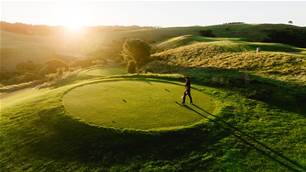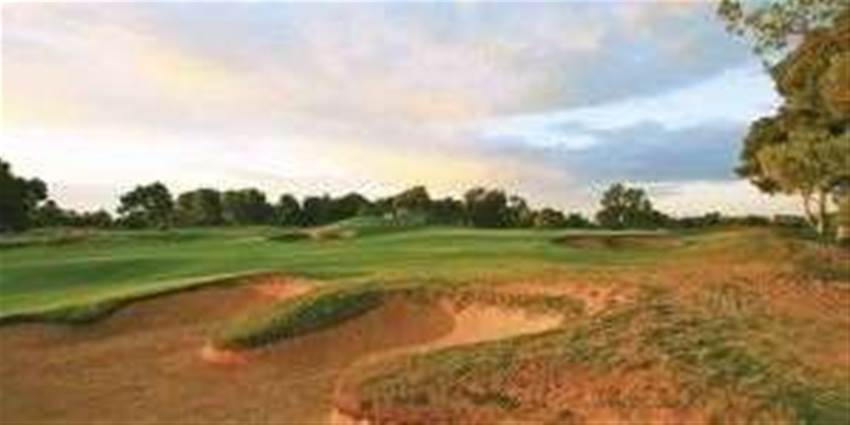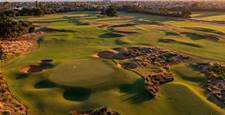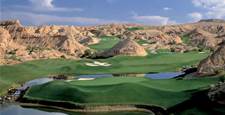Transformed by an extensive redesign, Genelg is no longer just one of Adelaide's premier layouts. It has blossomed to become one of Australia's elite courses.
Transformed by an extensive redesign, Glenelg is no longer just one of Adelaide’s premier layouts. It has blossomed to become one of Australia’s elite courses.
Glenelg is Adelaide’s most popular beachside suburb. The iconic City-to-Bay Tram terminates here and if you are into trivia, you will know Glenelg also has the best known palindromic place name in Australia.
Established in 1836, Glenelg is the oldest European settlement on mainland South Australia. Today, there are still some visible links back to its earliest decades, including the town hall building and the now named Glenelg Jetty Hotel, which dates back to 1869. The past decade has seen the Jetty Rd precinct of Glenelg transformed and you will now find plenty of cafes, restaurants and bars lining the strip.
One thing you won’t find in Glenelg is the golf club. It is actually in the adjoining suburb of Novar Gardens and was originally opened for play in 1926, having been crafted by Herbert ‘Cargie’ Rymill, who had helped found Royal Adelaide Golf Club and was behind the creation of the nearby Kooyonga course.
The expansion of Adelaide Airport after World War II saw the course redone under the supervision of designer Vern Morcom. Morcom, who was the head greenkeeper at Kingston Heath for nearly 40 years and a prolific designer of courses in Victoria during that time, laid out the course across sand-dune terrain and through a pine forest. His work went relatively unchanged for 50 years with the exception of a not-so-wise practice of regularly planting all manner of trees and some ti-tree.
By 1998, there were parts of the course that were terribly overgrown.
I can recall playing Glenelg during the week of the Australian Open that year. Playing alongside some media colleagues from the United States, who were out here to cover the Presidents Cup the following week, their take on the course was interesting. “Beautifully presented, but losing balls in trees and scrub is not a lot of fun,” was the consensus. I had not lost any balls that day so the overplanted nature of the course didn’t readily hit home.
The Americans would recognise the course today and they would be happy and relieved at how the course has been transformed from a premier Adelaide layout to one of Australia’s elite courses.
In fact, at the time of our round in 1998, the club had already set the wheels in motion to change the course. The club commissioned course architect Neil Crafter – in collaboration with long-time Glenelg member, top amateur golfer and tournament promoter Bob Tuohy – to rejuvenate the Glenelg layout to incorporate much of its original
links characteristics.
A major feature of the redevelopment wasn’t in a building form but the removal of trees and bushes, which had, over time, cluttered the layout. One of the goals of the designers was to create a more open, links feel to the course. To that end, vast areas of ti-tree and other bushes were removed, which had the effect of opening up previously unknown views and playing lines on many holes.
The redesign took almost seven years to complete and also included re-routing almost half the course, rebuilding most of the bunkers, improving its drainage as well as converting its kikuyu grass fairways and surrounds to Santa Ana couch grass. The greens were also converted to smooth-rolling bentgrass.
The changes to the bunkering were not only necessary but also breathed new life into the course and are now the outstanding feature of the design. Crafter and Tuohy incorporated a revetted, sod-stacked bunkering style – like that commonly found on Scottish links – on many holes to enhance the links look and feel of the layout.
The short par-4 opening hole is a gentle introduction to the Glenelg course but the scene is really set once you stand on the next tee. The 410-metre 2nd is the first of two strong par-4s on the front nine and it encapsulates all the characteristics the redesign was searching for. A large sand dune on the inside of the dogleg-left fairway is covered with tufty grasses and pine trees and is a real ‘no go zone’ from the tee. But the best driving line, especially for longer hitters, is to the left half of the fairway to not only get the shortest approach into the green but also to avoid a lone pot bunker sitting on the outside corner of the dogleg. Another small greenside pot bunker short left and a sprawling bunker to the right confirm that any approach to this putting surface is best made from the left half of the fairway.
More than 90 predominantly ochre-coloured bunkers – from small pots to large, sprawling Melbourne Sandbelt-style sand traps – cover the terrain and are a memorable feature. Both varieties can be lying alongside each other on the same hole, like they do on the short par-4 4th. Trees and bushes were removed from both sides of the 315-metre hole to expose the hole and, perhaps, tempt the long hitter to blaze away with the driver. A penal pot bunker lies about 25 metres short of a much larger fairway trap on the right of the lay-up area, so accuracy must accompany caution from the tee here. Five more bunkers and some mounding surround the large putting surface.
The second tough par-4 on the outward half is the 400-metre 6th, which can prove to be a real beast when the prevailing south-westerly wind blows with any real strength. When the wind blows from this direction it is a long hit to reach the corner of the dogleg left and, therefore, a tough ask to find the green in two blows. The hole doesn’t get any easier downwind as a small cluster of bunkers on the outside of the dogleg comes into play. The penalty for finding the sand from
the tee is not being able to reach the green in two. The slightly raised and narrow putting surface is heavily bunkered on both sides so accuracy from the fairway is important for any player with aspirations
of par or better.
For mine, the sequence of holes from the 2nd to the 7th is a real highlight on a course that has its fair share of showpiece holes.
The back nine opens with a another long two-shotter, this time a 382-metre journey over the crest of hill, past a huge scheme of bunkers on the right and tall pines left and right to reach a three-levelled green, which is protected left, right and behind by sand. These bunkers frame the green beautifully and as you stand in the fairway preparing to hit your second shot and do prove quite intimidating.
The bunkering on two of the three back nine par-3s makes them not only challenging but a memorable highlight of any round at Glenelg. The 168-metre 11th hole usually plays into the teeth of a south-westerly, making the elevated and narrow green a tough target. Complicating this task is a scheme of three huge bunkers right of the green, which slopes markedly from back to front.
Beautifully framed by native vegetation, the 164-metre par-3 14th hole calls for a well-struck mid-iron over wetlands to find the green that has five bunkers – three left and two right – scattered around its edges. A running approach in windy conditions must be shaped from left-to-right to avoid a sixth bunker lying 20 metres short of the putting surface.
Enhancing the Crafter and Tuohy redesign are the impeccable greens and fairways. The smooth and true rolling bentgrass greens are generally firm under foot, as are the fairways, which adds to the strategy players require to score well around this terrific course.
THE COURSE
LOCATION: James Melrose Rd, Novar Gardens. It’s about five minutes drive from Jetty Rd, Glenelg, and 15 minutes from the Adelaide CBD.
CONTACT: (08) 8295 3793.
WEBSITE: www.glenelggolf.com
DESIGNERs: Vern Morcom (1948); Neil Crafter and Bob Tuohy (1998 to 2006).
PLAYING SURFACES: Santa Ana couch (fairways and tees), bent (greens).
PGA PROs: Shane Robinson (director of golf), Gareth Jones (AAA-rated teaching pro).
GREEN FEES: $160. Glenelg is a private club but visitors from interstate and overseas can seek a tee-time via the general manager. Member’s guests: $60.
THE CLUB
MEMBERSHIPS: Glenelg Golf Club has strategically reduced lengthy waiting periods to join the club. They welcome all new members by giving them immediate access to the outstanding facilities. There is a wide range of membership options. To see what might be appropriate for you, check the club’s website.
CORPORATE AND GROUP DAYS: Glenelg hosts more than 40 corporate days a year with the team offering a variety of package options.
ACCOMMODATION: The Watermark Glenelg is a member of the Golden Chain network and has 14 beautifully appointed rooms and a three-bedroom family unit. Prices start from $140 per double, per night, including a light continental breakfast. The Watermark is only minutes away from the Jetty Road shopping and entertianment precinct and Glenelg Beach. For bookings call 1800 811 881.
Related Articles
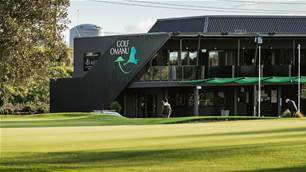
International Spotlight: Omanu Golf Club
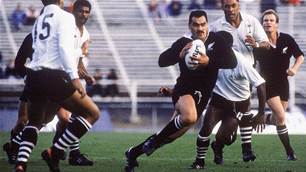
Celebrity Kiwi couple tee off in paradise
